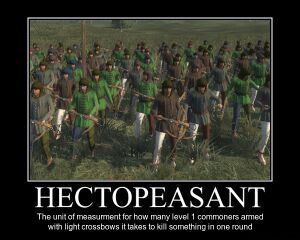Hectopeasant

A hectopeasant is the amount of damage one-hundred peasant NPCs can do in a single turn using cheap ranged weapons of average quality in clear conditions against a stationary peasant-sized target. This is used to measure the durability of creature in a gaming system. i.e.: "You can take down an young red dragon with 9.37 hectopeasants."
The hectoPeasant can also be used to describe a character's ability to deal damage. Calculate the hectoPeasant value of a given opponent, then substitute the character's own attack bonus and average damage. Compare the two.
Hectopeasant calculations necessarily vary from gaming system to gaming system. Some creatures may be completely invulnerable to the damage any peasant can inflict, able to sustain technically infinite-peasant damage. This can have several root causes, from a general incompetence of the peasantry to extraordinary armour the creature. These creatures will require heroes to defeat, and are thus a dire menace to the peasant ecology.
Methods
In systems with hit points or equivalent, it's simple arithmetic:
There's other factors such as the possibility of critical hits for extra damage, or overwhelming damage soaking curves.
For Dungeons & Dragons 3.5, a hectopeasant will do (2.5 + ((.05/P) * P * 2.5) * P * 100 hitpoints damage, where P is the probability of hitting the target ((20 - Armor Class) * .05, minimum of .05). An arrow does 1d4 damage, with a crit range of 20. Against a monster that has DR5, only critical hits will do damage so the formula is ((.05/P) * P * 1) * P * 100 . A hectopeasant will do 0 damage to any monster with DR8 or better.
For Dungeons & Dragons 5th edition, this is ((4.5 + (0.05 * 4.5)) * ((21 - ArmorClass) +2) * 0.05) * 100. This is the average damage of an arrow (1 eight-sided die) plus the 5% chance for double damage (rolling 20 on a 20-sided die), times the to-hit probability (rolling AC or better on d20), multiplied by 100 peasants. Creatures with resistance to piercing weapons take only half damage, so double the hectopeasant number. Creatures with an Armor Class above 22 are still hit on a natural die result of 20, so the minimum to-hit probability is always 5% or .05 .
For GURPS, it is bloody complicated. If the target is unarmored (PD0 DR0), stationary but not prone, and is not using one of the three active defense maneuvers, a hectopeasant (0-point character, no skills) using a normal crosswbow, not making a snap-shot but not spending one turn aiming, a hectopeasant will do 120.56 points of damage.
Practicality
The hectoPeasant is not meant to be a practical option in actual game play. The issues that arise from getting a hundred commoners formed up and armed with light crossbows in such a way as to actually let them all attack a target are beyond the scope of the hectoPeasant standard, and should be treated as a normal adventuring opportunity.